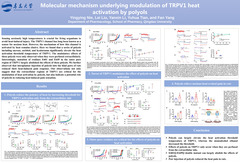Molecular mechanism underlying modulation of TRPV1 heat activation by polyols
ID:71
Submission ID:12 View Protection:ATTENDEE
Updated Time:2021-08-03 19:17:03 Hits:1649
Poster Presentation
Abstract
Sensing noxiously high temperatures is crucial for living organisms to avoid heat-induced injury. The TRPV1 channel has long been known as a sensor for noxious heat. However, the mechanism of how this channel is activated by heat remains elusive. Here we found that a series of polyols including sucrose, sorbitol, and hyaluronan significantly elevate the heat activation threshold temperature of TRPV1. The modulatory effects of these polyols were only observed when they were perfused extracellularly. Interestingly, mutation of residues E601 and E649 in the outer pore region of TRPV1 largely abolished the effects of these polyols. We further observed that intraplantar injection of polyols into the hind paws of rats reduced their heat-induced pain response. Our observations not only suggest that the extracellular regions of TRPV1 are critical for the modulation of heat activation by polyols, but also indicate a potential role of polyols in reducing heat-induced pain sensation.
Keywords
TRPV1, polyols, heat activation, thermal activation threshold, outer pore region
Submission Author
TianYuhua
Qingdao University
NieYingying
Qingdao University
LiuLei
Qingdao University
杨帆
Zhejiang University




Comment submit